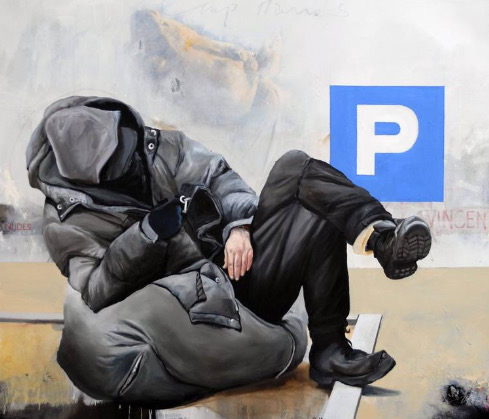
Art has long served as a medium for reflection, storytelling, and social critique. Among contemporary painters, Chris Stevens stands out as an artist who consistently challenges the viewer’s perception of identity, class, and social structure. His figurative paintings capture the raw essence of human experience, often focusing on the marginalized, forgotten, or overlooked.
One of his most notable works, “176 Boulevard Saint-Michel,” exemplifies this approach. This painting is a deeply evocative representation of a man living on the streets of Paris—an image that carries both emotional weight and political undertones. Stevens’ meticulous attention to detail, combined with his ability to convey powerful narratives, makes this painting a poignant statement on urban isolation, social disparity, and human resilience.
As we explore this piece and its creator, we gain insight into the broader significance of Stevens’ work, his influences, and the way he uses art to document and question society’s structures.
Chris Stevens: A Visionary in Figurative Art
Chris Stevens is a British figurative painter whose work challenges media-driven stereotypes. Since earning his Fine Art degree from the University of Reading in 1978, Stevens has exhibited widely, gaining recognition for his ability to create compelling socially conscious portraits.
His paintings often depict individuals within specific social environments, exploring themes of race, class, and identity. Stevens’ work is characterized by photorealistic precision blended with a layer of narrative depth—a combination that invites viewers to engage with his subjects beyond their superficial appearance.
Through his detailed brushwork and evocative compositions, Stevens not only captures the physical likeness of his subjects but also provides a glimpse into their lived experiences and inner worlds.
“176 Boulevard Saint-Michel”: A Story of Struggle and Survival
Stevens’ painting “176 Boulevard Saint-Michel” is more than just a striking portrait; it is a social statement. The piece was inspired by an encounter he had in March 2020, just before the world entered lockdown due to the COVID-19 pandemic.
While walking along Boulevard Saint-Germain in Paris, Stevens noticed a man living on the streets, his presence starkly contrasting with the elegant surroundings. The image stayed with him, prompting him to capture the man’s reality in oil on canvas.
The Power of the Image
The painting’s composition draws the viewer in with its intense realism. The subject is depicted in a moment of quiet introspection, his expression revealing layers of emotion—fatigue, resilience, dignity, and perhaps a sense of detachment from the bustling world around him.
Stevens’ use of color and texture enhances the work’s narrative depth:
• The muted tones of the man’s clothing highlight the wear and tear of life on the streets.
• The contrast between the rough texture of his face and the smooth background suggests a disconnection between his world and the affluent city that surrounds him.
• The attention to detail in his gaze, his hands, and the creases of his clothing serves as a reminder that this is not just a figure in a painting—it is a real person with a story.
By capturing this moment, Stevens forces the audience to confront the reality of homelessness and poverty—issues that are often ignored or dismissed in major urban centers.
Art as Social Commentary: A Consistent Theme in Stevens’ Work
Chris Stevens is not an artist who paints for aesthetic pleasure alone. His work often serves as a critique of societal structures, questioning how race, wealth, and power shape our interactions and perceptions.
His previous pieces have explored:
• The glamorization of wealth versus the reality of poverty
• The dehumanization of marginalized communities
Like many of his other works, “176 Boulevard Saint-Michel” fits within this tradition of socially engaged art. By choosing to depict an individual experiencing homelessness, Stevens is making a deliberate statement about social inequality and the visibility (or invisibility) of certain groups in society.
The Role of Location in the Painting’s Message
The setting of Boulevard Saint-Michel adds another layer of meaning to the piece. Located in the 5th arrondissement of Paris, this boulevard is historically known for its intellectual and artistic heritage. Home to the Sorbonne University, bookstores, and cultural institutions, it represents a place of knowledge, power, and privilege.
By placing a homeless man at the center of this setting, Stevens juxtaposes two worlds that rarely intersect:
The world of academia, culture, and intellectual elitism
The reality of urban poverty and social exclusion
This contrast challenges viewers to reconsider their assumptions about space, identity, and belonging. It asks: Who truly “belongs” in these prestigious areas? Who is seen, and who is ignored?
Recognition and Reception of the Painting
“176 Boulevard Saint-Michel” has been well received in the art world, where it is available for purchase. Priced at $15,730, the painting has attracted attention from collectors who appreciate both its artistic execution and its powerful message.
Stevens’ ability to merge technical mastery with compelling storytelling has made this work a standout piece. Art critics have praised:
• The realism of the portrait
• The emotional depth of the subject
• The social relevance of the theme
In many ways, this painting serves as a continuation of the long tradition of socially conscious art, reminding viewers that art has the power to shed light on overlooked issues.
Chris Stevens and the Future of Figurative Art
Stevens continues to work between London and the south of France, creating art that remains both visually stunning and socially thought-provoking.
Themes That Define His Artistic Vision:
• Representation of marginalized communities
• Challenging societal stereotypes
• Examining race, class, and power in contemporary society
In an era where art is increasingly seen as a tool for activism, Stevens’ work stands out as a testament to the power of figurative painting. While many contemporary artists turn to digital media and abstract expressionism, Stevens remains committed to the tradition of portraiture as a means of storytelling.
Impression
At its core, “176 Boulevard Saint-Michel” is more than just a painting—it is a call to awareness and empathy. It forces viewers to look beyond their comfort zones and acknowledge the human stories behind social issues.
Chris Stevens has used his art to give a face to the forgotten, and in doing so, he continues to shape the conversation around representation, inequality, and the role of art in society.
In a world that often turns a blind eye to those struggling on the margins, paintings like this serve as a reminder of our shared humanity.
No comments yet.








